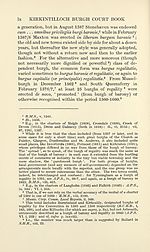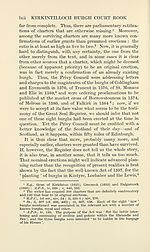Series 3 > Court book of the Burgh of Kirkintilloch 1658-1694
(68) Page lxi
Download files
Complete book:
Individual page:
Thumbnail gallery: Grid view | List view

INTRODUCTION
Ixi
Included among the burghs thus erected or given a new
status were many places of importance in the economic and
social organisation of the kingdom : some indication of
their standing is afforded by the fact that, during the cen¬
tury now under consideration, no fewer than 18 of them
were advanced to the rank of royal burgh.1 A few other
ancient burghs now reappearing as burghs of regality or
barony were also noteworthy towns—Musselburgh (1562),
Canongate (1587), Airth (1597), Prestwick (1600) and Kelso
(1614)—and there is record evidence of continued municipal
life at such substantial and well-established burghs of the
preceding age as Dalkeith, Dunkeld, Kirriemuir, Kirkin¬
tilloch, Maybole and Paisley. So, too, the genuine de novo
creations of the time were often of burghs that took firm
root in the civic and commercial life of their region. In the
far north, for example—where burghs were a rarity—there
were now Inverbrora (1601) and Thurso (1633); in the
north-east, Keithinch (or Peterhead) and Stonehaven
(both in 1587) ; in the midlands, Edzell (1588), Ferry Port
on Craig (1599), Coupar Angus (1607), Meigle (1608) and
Errol (1648); on or near the shores of the Firth of Forth,
St. Monans (1596), Elie (1599), Falkirk (1600), Leven (1609)
and Tranent (1619); in the south-east, Greenlaw (1596),
Eyemouth (1598), Galashiels (1599) and Coldingham
(before 1638 2); in the south-west, Kilmarnock (1592),
Minnigaff (1619), Portpatrick (1620), Langholm (1621),
Largs (eventually in 1631 3), Greenock (1635), Moniaive
(1636) and Moffat (1648).
Some caution is called for in considering this series of
charters. The Great Seal Register appears to be tolerably
full for those hundred years, but we know that it is in fact
1 Cf. infra, pp. Ixxiv-lxxv.
2 The burgh of barony was re-erected in that year, when its commerce
had decayed, and there were doubts as to the superiority : R.M.S., ix, 815.
3 This grant in effect superseded two earlier attempts at erection, one
in 1595 in favour of Brisbane of Bishopton, the local landowner (Newtoun
of Gogo), and the other in 1629 in favour of Sir William Alexander of
Menstrie, the great speculator of his day (Largs) ; in the end the conflict
was settled by a victory for the local man. Cf. Collections of Ayrshire
Archaeol. and Nat. Hist. Soc., new ser., vol. 4 (1955-57), 33.
Ixi
Included among the burghs thus erected or given a new
status were many places of importance in the economic and
social organisation of the kingdom : some indication of
their standing is afforded by the fact that, during the cen¬
tury now under consideration, no fewer than 18 of them
were advanced to the rank of royal burgh.1 A few other
ancient burghs now reappearing as burghs of regality or
barony were also noteworthy towns—Musselburgh (1562),
Canongate (1587), Airth (1597), Prestwick (1600) and Kelso
(1614)—and there is record evidence of continued municipal
life at such substantial and well-established burghs of the
preceding age as Dalkeith, Dunkeld, Kirriemuir, Kirkin¬
tilloch, Maybole and Paisley. So, too, the genuine de novo
creations of the time were often of burghs that took firm
root in the civic and commercial life of their region. In the
far north, for example—where burghs were a rarity—there
were now Inverbrora (1601) and Thurso (1633); in the
north-east, Keithinch (or Peterhead) and Stonehaven
(both in 1587) ; in the midlands, Edzell (1588), Ferry Port
on Craig (1599), Coupar Angus (1607), Meigle (1608) and
Errol (1648); on or near the shores of the Firth of Forth,
St. Monans (1596), Elie (1599), Falkirk (1600), Leven (1609)
and Tranent (1619); in the south-east, Greenlaw (1596),
Eyemouth (1598), Galashiels (1599) and Coldingham
(before 1638 2); in the south-west, Kilmarnock (1592),
Minnigaff (1619), Portpatrick (1620), Langholm (1621),
Largs (eventually in 1631 3), Greenock (1635), Moniaive
(1636) and Moffat (1648).
Some caution is called for in considering this series of
charters. The Great Seal Register appears to be tolerably
full for those hundred years, but we know that it is in fact
1 Cf. infra, pp. Ixxiv-lxxv.
2 The burgh of barony was re-erected in that year, when its commerce
had decayed, and there were doubts as to the superiority : R.M.S., ix, 815.
3 This grant in effect superseded two earlier attempts at erection, one
in 1595 in favour of Brisbane of Bishopton, the local landowner (Newtoun
of Gogo), and the other in 1629 in favour of Sir William Alexander of
Menstrie, the great speculator of his day (Largs) ; in the end the conflict
was settled by a victory for the local man. Cf. Collections of Ayrshire
Archaeol. and Nat. Hist. Soc., new ser., vol. 4 (1955-57), 33.
Set display mode to:
![]() Universal Viewer |
Universal Viewer | ![]() Mirador |
Large image | Transcription
Mirador |
Large image | Transcription
Images and transcriptions on this page, including medium image downloads, may be used under the Creative Commons Attribution 4.0 International Licence unless otherwise stated. ![]()
| Scottish History Society volumes > Series 3 > Court book of the Burgh of Kirkintilloch 1658-1694 > (68) Page lxi |
|---|
| Permanent URL | https://digital.nls.uk/126713979 |
|---|
| Attribution and copyright: |
|
|---|
| Description | Over 180 volumes, published by the Scottish History Society, containing original sources on Scotland's history and people. With a wide range of subjects, the books collectively cover all periods from the 12th to 20th centuries, and reflect changing trends in Scottish history. Sources are accompanied by scholarly interpretation, references and bibliographies. Volumes are usually published annually, and more digitised volumes will be added as they become available. |
|---|


